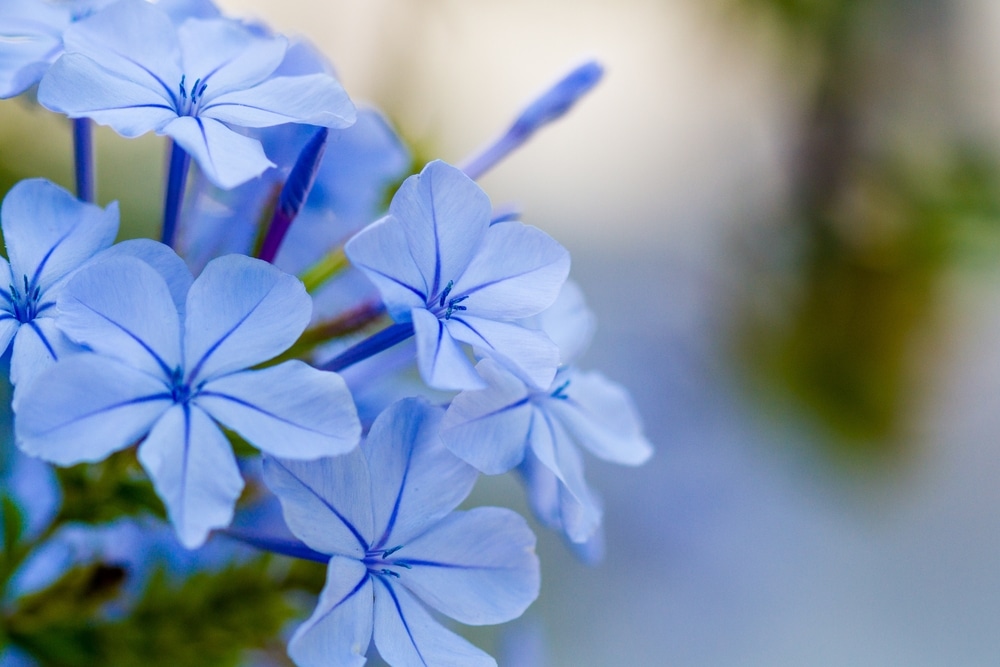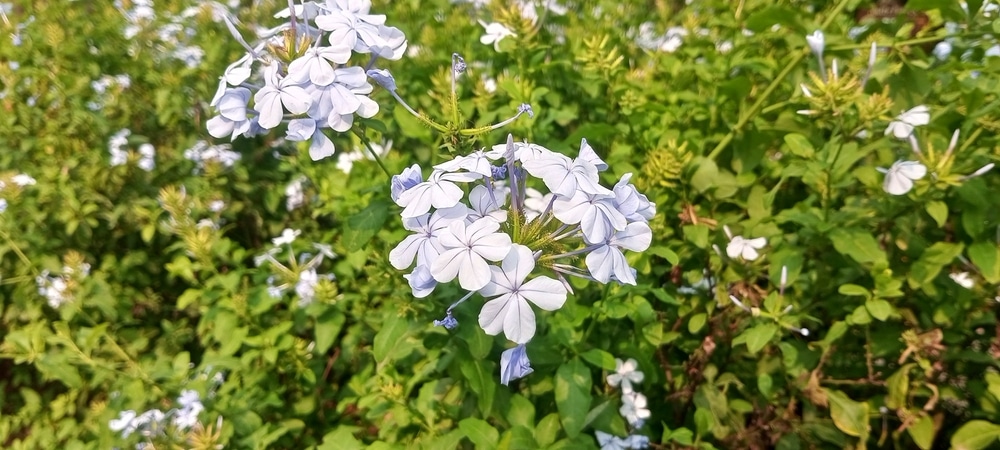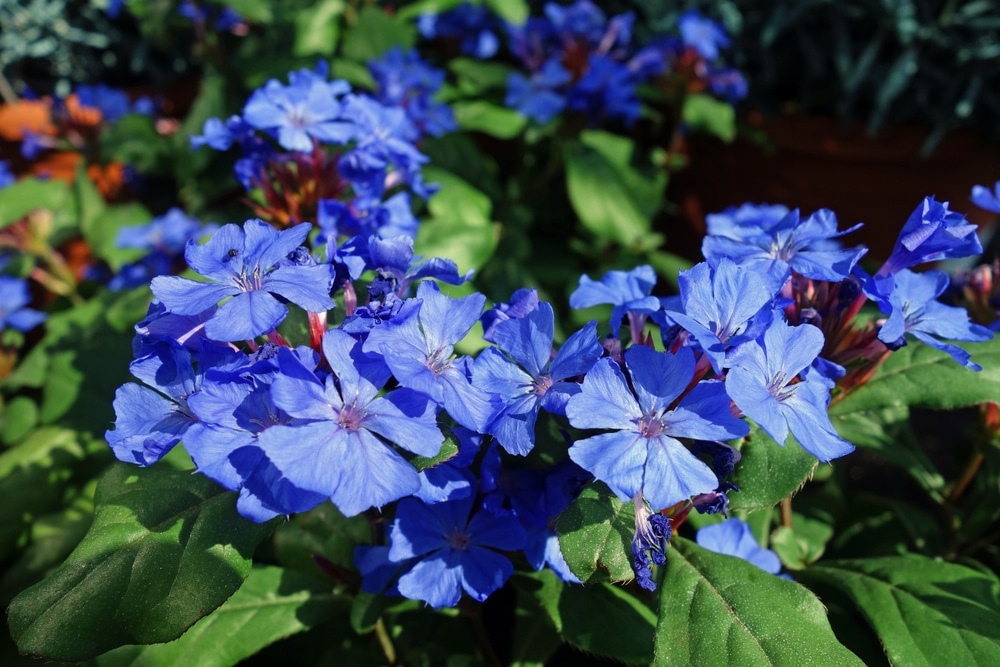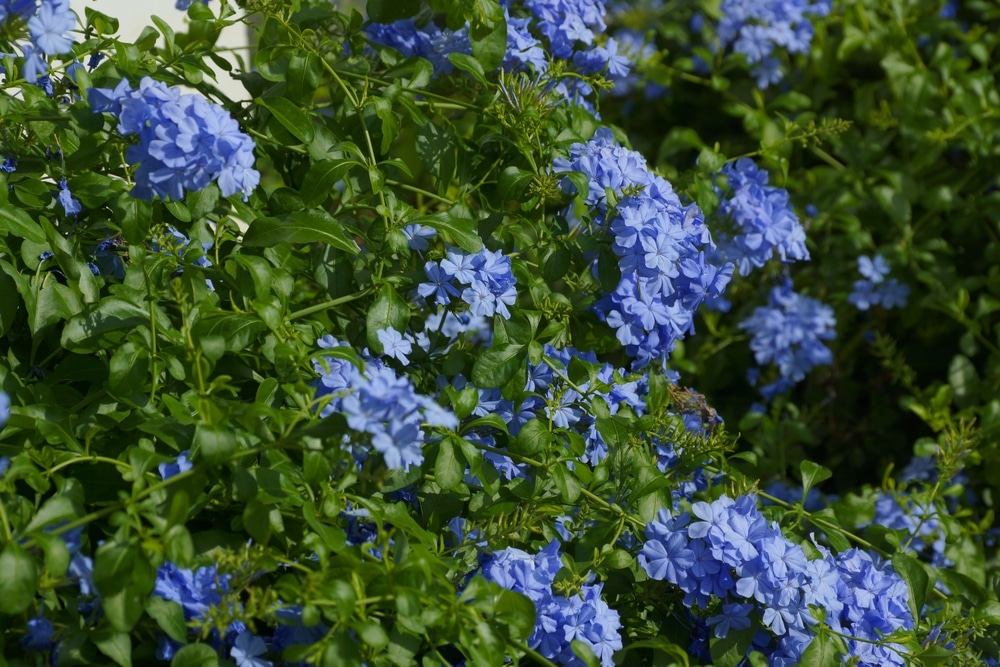Plumbago Overview
Plumbago plants, also known as blue plumbago, Plumbago auriculata, or Cape plumbago, are native to South Africa and known for their strikingly beautiful flowers.
These versatile plants can be found in various settings, such as indoor and outdoor gardens, and add a touch of elegance to landscapes with their cascading clusters of blue, white, or pink blossoms. As a gardener, you’re likely searching for a unique and rewarding plant to grow, and plumbago may just be the perfect fit for your needs.
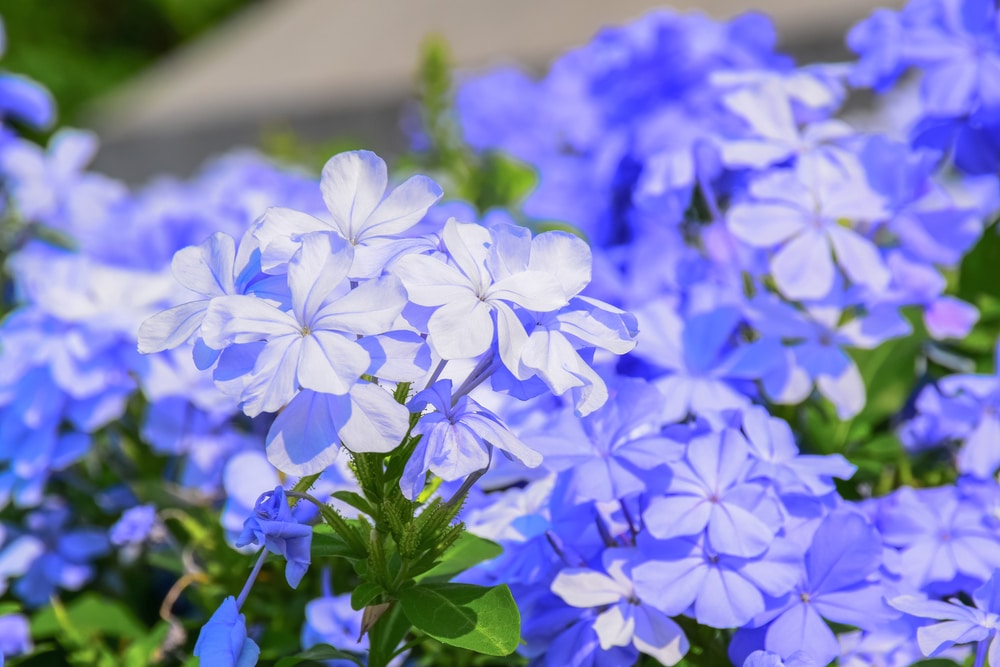
Cape plumbago, a herbaceous perennial, thrives in warm climates like Florida or Texas. However, with proper care, you can also grow it in various environments outside its optimal zones.
Plumbago capensis is a climber with a fast growth rate, which means it can quickly spread and provide an attractive element in your garden. Its pale blue flowers resemble phlox and are exceptionally popular with butterflies, making it an ideal addition to a pollinator-friendly space.
In order to have success with plumbago plants, it’s essential to learn about their specific growing conditions, planting, and care requirements.
Whether you plan on growing plumbago indoors or outdoors, understanding its preferences and nurturing it accordingly will yield beautiful, flourishing plants and flowers.
Species and Varieties
Cape Plumbago
Cape Plumbago, also known as Plumbago auriculata or blue cape plumbago, is a popular species native to South Africa. It naturally grows as an evergreen shrub in zones 9-11, showing off its beautiful blooms all year round.
The flowers are typically a rich blue color, making it a great addition to create contrast in your garden. For the best results, provide well-draining soil and plant it in an area with full sun to partial shade.
Landscaping Plumbago
Landscaping plumbago comes in several varieties and can be an attractive addition to your garden. They are versatile plants, suitable for climbing, ground cover, or as potted plants, depending on the specific species and your climate. Some common landscaping plumbago varieties include:
- C. plumbaginoides: Rich blue flowers, suitable for USDA plant hardiness zones 5-9.
- Plumbago zeylanica: Also known as P. scandens, it is more commonly found in Florida.
When planning your landscaping with plumbago, consider factors like the plant’s growth habits and characteristics as well as the overall design of your garden. It is important to remember that plumbago prefers well-draining soil and a mix of sun and partial shade, particularly in warmer climates.
Blue Plumbago
Blue plumbagos are admired for their vibrant blue flowers. Blue cape plumbago is a popular variety, characterized by its sky-blue flowers that bloom throughout the year in warmer climates.
Another beautiful option is the blue plumbago flower, or C. plumbaginoides, which also showcases rich blue blooms. They make excellent ground covers, creating striking blue carpets in your garden.
When planting blue plumbago, ensure that your chosen location has well-draining soil and receives a mix of full sun and partial shade. Proper care and maintenance will reward you with stunning, continuous blooms.
Growth and Care
Plumbago Hardiness
The plumbago plant, also known as the Cape plumbago or sky flower, is native to South Africa and thrives in warm climates. It is an evergreen shrub that can grow 6 to 10 feet tall with a spread of 8 to 10 feet.
Plumbago hardiness is best suited to hardiness zones 9 to 11. In cooler climates, it’s best to grow the plumbago in containers and move them indoors during the cold months.
Planting Conditions
Plumbago plants prefer well-draining soil and can tolerate a variety of soils. They can grow in partial shade to full sun exposure but perform best in part shade. When planting in early spring, space the plants about 3 feet apart to accommodate their fast-growing nature.
Optimal planting conditions:
- Well-draining soil
- Partial shade to full sun exposure
- Plant spacing: 3 feet apart
Care Details
To ensure proper plumbago care, watch out for the following aspects during the growing season:
- Watering: Although plumbago is drought-tolerant, it’s important to water regularly, especially during the first year, to promote healthy root development. Afterward, reduce the frequency but continue watering to maintain a moist, but not soggy, soil condition.
- Pruning: Regular plumbago pruning keeps the plant looking tidy and encourages a bushier growth habit. Prune the shrub after the blooming period or during early spring by cutting back the stems to the desired shape and size.
- Fertilizing: Apply a slow-release, balanced fertilizer in early spring to support the plumbago’s growth and encourage abundant flowering.
- Pest control: Plumbago plants are deer resistant, but they might attract other pests such as aphids. Check your plants regularly for any signs of infestation and treat with insecticidal soap or a suitable pesticide if necessary.
Propagation
Propagating plumbago plants can be easily done by taking stem cuttings. Follow these steps to ensure successful propagation:
- Choose a healthy, non-flowering stem that is at least 4 inches long.
- Remove the bottom leaves, leaving only the top set of leaves.
- Dip the cut end in rooting hormone to promote root growth.
- Plant the cutting in a well-draining soil mix, such as a combination of potting soil and perlite or sand.
- Keep the soil consistently moist and place the cutting in a location with bright, indirect light until new growth appears, indicating successful rooting.
By following these guidelines, you can confidently grow and care for plumbago plants, adding a touch of vibrant color to your garden or landscape.
Plumbago in Landscape
Plumbago is a beautiful and versatile plant that can play a valuable role in your landscape design. It can be used as a foundation planting or incorporated into various garden styles. In this section, we will discuss how to effectively incorporate plumbago in your landscape.
When selecting a location for your plumbago plant (Plumbago auriculata), also referred to as the Cape plumbago or sky flower, consider its native environment. It originates from South Africa and grows well in warm climates, reaching 6 to 10 feet in height with a spread of 8 to 10 feet. Therefore, it’s essential to provide ample space for the plant to grow and flourish.
One popular way to use plumbago in landscape design is as foundation planting. This helps to soften the appearance of your home’s foundation, creating a more inviting and visually appealing space. To achieve this, plant plumbago around the base of your home, spacing each one about 3 feet apart to provide room for growth. As it matures, the plant’s vibrant blue flowers will create a stunning contrast against the structure.
Beyond foundation plantings, plumbago can also be used in other landscape areas, such as along walking paths, to create a vividly colored border. The low-maintenance nature of plumbago makes it an ideal choice for such settings, as it requires minimal ongoing care to maintain its beauty.
In addition, plumbago can be effectively incorporated into various garden styles, including tropical, Mediterranean, and cottage gardens. The bright blue blooms and lush green foliage of the plumbago plant work well alongside other plants with similar growth habits and color schemes.
To optimize the impact of plumbago in your landscape, consider partnering it with companion plants that complement its growth and appearance. Some options include:
- Lantana: With its bright and long-lasting blooms, lantana offers a striking contrast to plumbago’s cool blue flowers.
- Salvia: The tall spikes of salvia flowers can add height and depth to your planting area, creating visual interest.
- Hibiscus: The bold, colorful flowers of hibiscus plants work well alongside plumbago, providing an additional pop of color.
Remember, when incorporating plumbago into your landscape design, it’s essential to select a suitable location, provide adequate space for growth, and explore companion planting options to enhance the plant’s beauty and impact. By following these guidelines, you can create a stunning and welcoming outdoor space that showcases the unique charm of plumbago.
Interesting Facts
Plumbago, also known as Cape Leadwort or Plumbago auriculata, is a versatile and eye-catching plant that originated in South Africa. Its name “plumbago” is derived from the Latin word “plumbum,” meaning lead. Historically, this plant was used as a treatment for lead poisoning.
Growing quickly and thriving in warm areas, you’ll often find plumbago plants adorning gardens in the southern United States, such as Texas and Arizona. They flourish in USDA hardiness zones 9-11. The plant has the ability to grow in a variety of settings, whether as a shrub, groundcover, or even a climbing vine.
The beautiful bluish-violet flowers of this shrub can make any garden stand out. They grow profusely, creating a visually captivating effect. The plumbago plant can reach heights of 6 to 10 feet tall and spread out to 8 to 10 feet wide.
To care for your plumbago plant, it’s important to prune it in early spring. This helps maintain the shrub’s shape and encourages healthy growth. Plumbago plants are also quite adaptable and can be grown in containers or used as a climbing annual in cooler climates.
Do keep in mind that plumbago can be toxic to dogs. Make sure to position it away from your pets’ reach to avoid any accidents or health issues.
